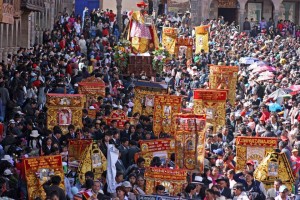
Kukuli Velarde, Patron Santiago (Corpus Series), red clay low fire, underglazes, casein, gold leaf and wax, 84 h x 49 d x 26.5 w cm, 2013
Kukuli Velarde is a Peruvian-born artist whose work deconstructs the Spanish colonisation of Andean peoples. Here she writes about the southern agenda behind her work:
Like the majority of Peruvians, I am the product of the forced combination of the european and the indigenous worlds, which ultimately can be seen also as the forced combination of two aesthetics. CORPUS is an attempt to explore and develop a body of work that visually narrates Peruvian history through physical syncretism, combining pre-Columbian and Colonial sensibilities within the objects created, in order to document our paradoxical idiosyncrasies. CORPUS is also a search for a truer Peruvian aesthetic than just the one taught by the victor. Once we are able to artistically represent what historically we have experienced, then can we successfully join in the larger community of nations and contribute to the wealth of international aesthetics… The European aesthetics, which is the international aesthetics today, was formed in the image and likeness of their creators, maybe it’s time to reflect and reconsider whether we, Peruvians, shouldn’t place ourselves at the center of our likes and dislikes, stopping being the dissonant ugly ones in the ‘movie’, the stone guests to a banquet to which we were not even invited.
Prior to the arrival of the Spanish, the city of Cusco had 350 Wakas, sacred places where representations of beneficial entities could be placed, linked to natural elements such as sun, water and corn. Colonisation involved the occupation of shrines, replacing many local gods with the one Jesus. The rite of Corpus has been held since 1572 when Viceroy Francisco Toledo received the order of the king of Spain to “fight” the Wakas of Cusco. This involves a procession of fifteen icons, representing religious figures such as Saint Sebastian and Santiago.
Velarde’s Corpus series reveals the indigenous figure harboured inside its official Christian mask. The pedestal is inspired in the actual platforms on which Santiago is carried in the Cusquenian Corpus. The form and designs of horse and man are drawn from Tiwanaku sculptures.
While exposing the hidden reality, the works also bring together the two worlds that house the mixed identity of someone like Velarde – ‘I am the product of the forced combination of the European and the indigenous worlds.’ Velarde’s work does not fit neatly into the essentialism of indigenismo, which seeks to de-colonise the Andean region, stripping away the traces of European colonisers. It is rather a carnivalesque play of cultures otherwise ordered hierarchically in order of whiteness. See her website for more examples of this prolific artist.




